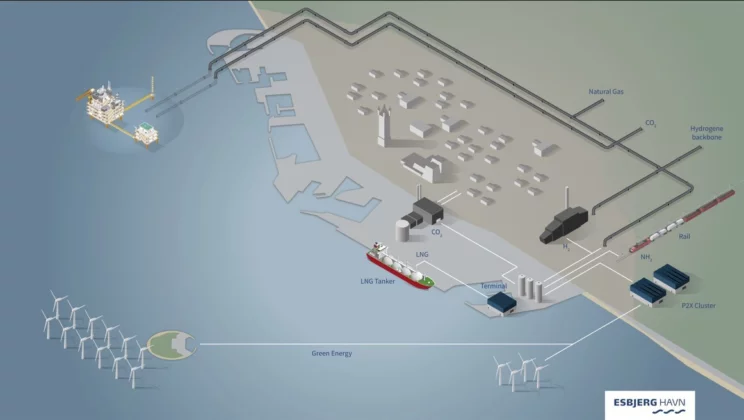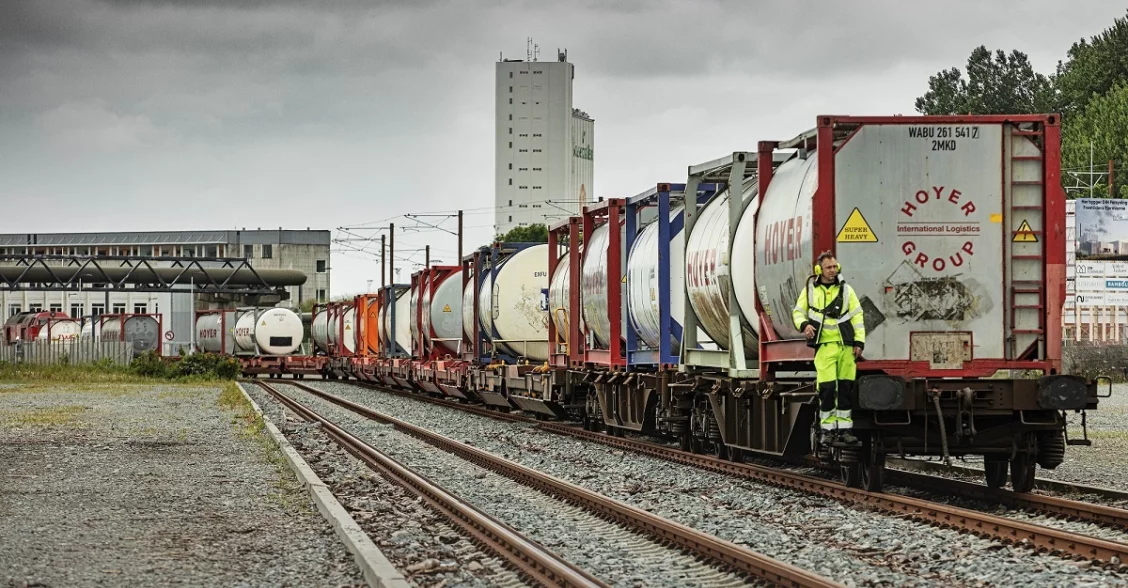Europe’s green transition is dependent on green fuels and decarbonisation. Transporting the new fuels requires next-level logistics, and Port Esbjerg will be playing a key role. DB Cargo and Port Esbjerg are ramping up their partnership, because the opportunities for using rail transport in the new infrastructure are vast, and as it is greener, rail transport will benefit the green transition.
Can trains be used to transport CO2 en route to the North Sea subsoil?
Yes.
Can trains be used to transport green ammonia from the fertiliser industry and the P2X plant scheduled to be built in Esbjerg?
Yes.
Can trains be used to transport hydrogen?
Yes.
In the years ahead, the need for green fuels and decarbonisation will increase significantly as European countries move forward with the green transition. Producing and distributing green fuels require logistics in the form of sea, road and rail transport.
Port Esbjerg already has ongoing projects involving hydrogen, green ammonia, e-methanol and carbon capture and storage in the North Sea. And Esbjerg is working towards becoming a so-called decarbonisation node.
This means that Port Esbjerg is able to provide infrastructure for the green transition, for example so as to enable the removal of greenhouse gases from energy production and thereby reduce or remove the carbon footprint to combat climate change.
Common to these projects is that railways may play a role in the transport of fuels and CO2 to and from Port Esbjerg and further afield around Europe.
“The sky’s the limit,” says Thomas Vestergaard, Head of International Sales Denmark at DB Cargo in Scandinavia.
His enthusiasm is fuelled not least by the fact that rail networks across Europe are so extensive that deliveries by rail is possible to almost all corners of Europe. Therefore, he believes that expanding the partnership with Port Esbjerg holds huge potential, not least because green fuels and green transport go hand in hand.

Overview of some of the possibilities for green fuels at Port Esbjerg.
More assignments will yield higher frequency
To date, DB Cargo has had two weekly services to and from Port Esbjerg, connecting it to the rest of Europe by train.
The services connect to two different networks, one via Taulov, from where trailers, containers and swap bodies can travel to any destination in Europe. LEO Pharma in Esbjerg has used this intermodal network for its raw materials, which are transported in tank containers.
Secondly, there is the so-called single wagon network, for example used for loading waste bales into train wagons in Italy and transporting them to Energnist in Esbjerg where they are converted into energy. In this network, you can also transport CO2, ammonia and the like, which DB Cargo is highly experienced in handling.
“This type of transport is the backbone of our business in countries like Germany, Austria and Switzerland. The area holds a huge development potential,” says Vestergaard of DB Cargo.
DB Cargo operates trains to and from the port of Aalborg five times a week, increasing the frequency to six weekly services after the summer holidays. The intention is to have an equally high frequency of trains to Esbjerg, but this requires additional transports, with green fuels holding huge potential.
Realising these great visions will require additional tracks, pipelines and drain systems.
“We believe that Port Esbjerg has the capacity to support and develop more green transport and thereby support this new industry within green energy. We were first movers in the wind industry. In the years ahead, there’ll be a need for transporting green fuels, and it’s obvious that we should seize this opportunity for Esbjerg to be a player in this next phase,” says Dennis Jul Pedersen, CEO of Port Esbjerg.
Huge potential for rail transport
According to Jul Pedersen, rail transport not only holds huge potential when it comes to transporting the new green fuels. Generally, he believes that green transport options should be prioritised for all the cargo currently being transported by road through Europe.
“Rail transport may sound a bit heavy, but a lot has happened in this field in recent years,” he says.
Jul Pedersen argues that intermodal rail transport networks have improved in recent years, today offering efficient and environmentally friendly transport of cargo over long distances, because rail transport emits less carbon than road transport.
According to Vestergaard, an 80 per cent CO2 reduction may be achieved by switching from road transport to rail transport.
“Even though you can load 3,000 tonnes of waste bales onto a vessel in Italy, and we can only carry 60 tonnes in a train wagon, carbon emissions per tonne of cargo are less with rail transport because the vessel would have to sail around the Iberian Peninsula. Generally, cargo transport in Europe can be made greener and smarter, if you combine the modes of transport and apply a more strategic line of thinking,” says Vestergaard.
The intermodal rail network in Europe comprises different train types and infrastructures, which are designed to provide efficient and reliable cargo and passenger transport across the continent. The system comprises high-speed trains, regional and commuter trains, freight trains, ferries and other types of transport which are integrated.
The primary form of intermodal land cargo transport in Europe is container transport by rail. Containers loaded with cargo are transported between different regions and countries in Europe, and the cargo is then typically loaded onto lorries or vessels for the final leg of the journey to the recipient. This approach is often more cost-effective too.
“Previously, it would have been necessary to book an entire train to have your cargo transported. Now you can buy only the wagons you need. If you have goods in Hamburg, rail transport may be a good idea, although road transport would probably be the most frequent choice by default,” says Jul Pedersen, with Vestergaard backing up his point:
“Sugar is transported from Lolland to Italy by road. Why not load it onto a train at Høje Taastrup and ship it by sea from Esbjerg to Italy?” asks Vestergaard.

According to Port Esbjerg, green transport options should be prioritised for all the cargo currently being transported by road through Europe.
Go to overview

